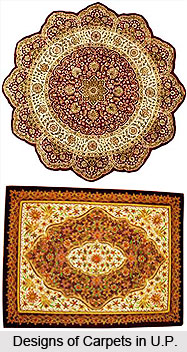 Carpets of Uttar Pradesh are particularly known all across the globe for its unique colours and designs. Employment in Uttar Pradesh constitutes almost 90 % of the carpet weavers. Bhadohi, Mirzapur and Agra are the major carpet hubs in Uttar Pradesh. Among these places, Bhadohi enjoys worth special mention as the economy of this district and its 500 odd villages are completely dependent upon the carpet business.
Carpets of Uttar Pradesh are particularly known all across the globe for its unique colours and designs. Employment in Uttar Pradesh constitutes almost 90 % of the carpet weavers. Bhadohi, Mirzapur and Agra are the major carpet hubs in Uttar Pradesh. Among these places, Bhadohi enjoys worth special mention as the economy of this district and its 500 odd villages are completely dependent upon the carpet business.
The specialty of Bhadohi carpets of Uttar Pradesh is their individual designs. These designs have been developed by the native weavers and also include various tints of Taj Mahal in natural color or Sirdar in subdued colors. The carpets of Uttar Pradesh come with hand imprinted or hand carved borders in rose-beige, honey, ivory and Iraq green. Another popular design of the carpets made in Uttar Pradesh is called `sculpture design` that uses clippings of the thread around the helm and gives it a 3-dimensional texture. Mostly bright colored pastel shades are used in this 18th century design pattern.
Agra in Uttar Pradesh was the first carpet center in the Mughal India. A very interesting system is followed here that has been oddly named `Calling Out` system. In this system the master weaver of carpets of Uttar Pradesh follows the design and keeps calling out to the weavers the colors to be used for each knot. The Iranian weavers took the real initiative of carpet weaving in Uttar Pradesh. Their designs besides the high quality of Cashmere wool resulted in the prosperity of Indian carpet. Presently, Uttar Pradesh is one of the most important centers in silk carpet exports and the general design of carpets in Uttar Pradesh is a combination of Iranian, Moroccan, French and Turkmen designs that are drawn by local designers and woven by weavers. Some of the famous designs are named after cities and provinces of Iran such as Sarough, Tabriz, Hamadan, Kashan, Isfahan and Khorasan. Mirzapur, Badohi, and Khamaria are the main towns boasting trained carpet weavers who produce the unique carpets of Uttar Pradesh
Twisted cotton thread is used along with the Jute twine thus giving rougher qualities of carpet with about 60 knots per square inch. Cotton and woolen carpets are mainly manufactured in Shahjehanpur and Agra where weavers produce long-established and also new motifs, keeping the market demand in mind.



















